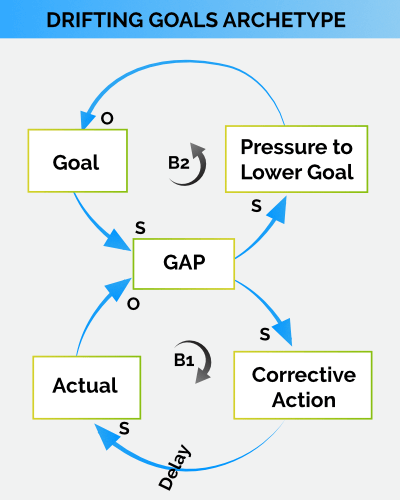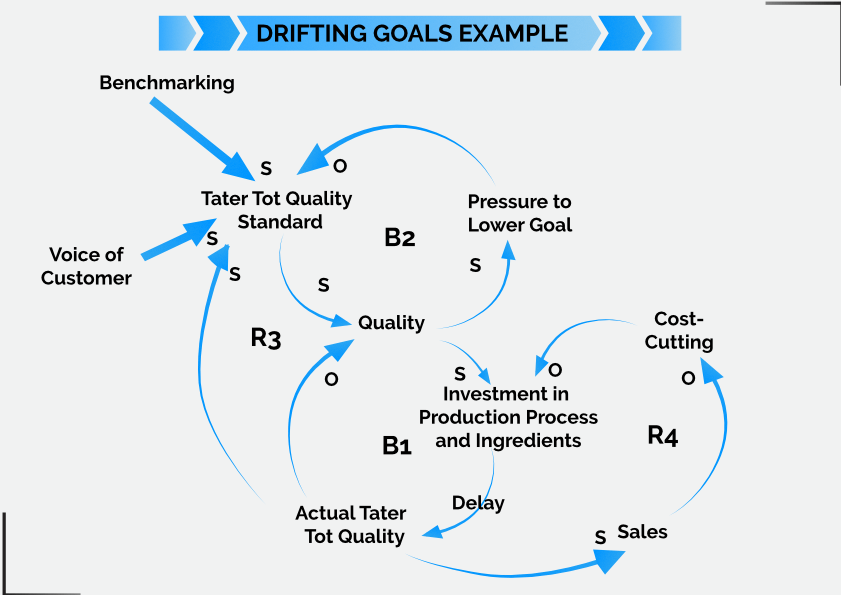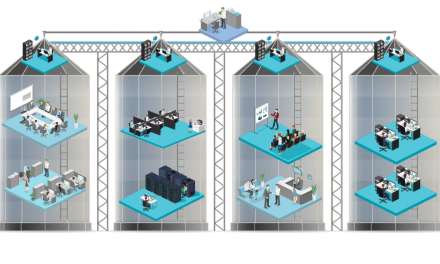Why aren’t organizations meeting their goals? For instance, why are sales dropping? Why has quality fallen behind so much? Why have delivery times increased overtime? I bet the first possible answers that come to mind are along the lines of ‘Customer preferences have changed’, ‘There must be something broken in the manufacturing process’, ‘The number of orders have increased and we just can’t keep up’. Sometimes the cause can be more simple but also unexpected at the same time: it is simply because we unintentionally and over time lowered our goals. We all have goals to meet, several ones at the same time and often they compete for our attention as well. Sometimes our focus on the goal gets undermined by the pressures we encounter elsewhere. We react to the pressure and unintendedly over time we drift further and further away from what we really are trying to achieve.
This article is part of a series
[series_post_list_box]
What can you expect from this article?
- You will find the answer to such questions to be both much simpler and more suprising than expected.
- You will learn to understand and recognize the “Drifting Goals’ Systems Thinking archetype so you can use it to analyse your own organization.
- You wil get practicable advise how to avoid the pattern.
Drifting Goals, an introduction
If you think this is a far-fetched scenario…it happens more often than you think. Even in our personal lives. Have you ever wondered why so many New Year resolutions fail? Let’s say you tell yourself you are finally committed to lose some weight. You know you should have started earlier but now you will make up for it. You set yourself an ambitious goal and get started. You start working out, watch your calorie intake, but it just takes time for your effort to take effect. Results are slow. Frustration grows. You tell yourself that it is better to temporary lower your goal, so it is more realistic and motivating. Instead of “No potato chips for the next five months!”… you end up with ”Okay, maybe just one bag a week max, that’s more doable”. Now the problem is that your new goal has become the new standard. Pressure is only temporarily relieved as we still have to work just as hard to keep losing weight. So before you know it you are on a slippery path downward and in an attempt to deal with the pressure you end up with exactly the opposite of what your were trying to achieve. It is often even more complex than this because we have several competing goals, and we might be temped to lower one goal which over-time has a negative effect on another. For instance, we might lower our weight-loss goal, temporary of course, because it is so busy at work lately which makes it hard to eat at regular times. “Let’s pick up the pace again when things at work slow down a bit”.
So, to come back to the questions we started with: we might have decreased prices as a reaction to missing our sales targets. We might have lowered quality targets temporarily in order to keep up with delivery schedules. We might have let delivery times slip in order to save on overtime as the pressure on cost savings was also tremendously high. In most situations the initial lowering of goals might not have been a bad thing in itself and was probably intended as temporary. But the drifting goals scenario only starts here, and it continues so gradually we sometimes need to hit a crisis level before we get aware that something is going on.
A closer look
Causal loop diagram
Systems Thinking archetypes are displayed as causal loop diagrams. Here’s the diagram for the Drifting Goals archetype.
Drifting Goals causal loop diagram
We see two balancing loops. The lower loop displays the gap between the actual and the desired state. The gap causes us to take corrective actions. However they will usually influence the actual state at a delay. So it takes a while before we see the results.
The other loop depicts the pressure to lower the goal because of the gap. This is also a balancing loop because we’ll keep being presured to lower the goals until the gap between desired and actual performance is closed.
Tater Tots
Let’s look at an actual case using the base archetype. Ore-Ida, a subsidiary of Heinz, noticed a drop in sales of Tater Tots2, between 1985 and 1987. They assumed this was caused by changing customer preferences. But further investigation revealed that the quality of the Tater Tots had gradually declined over time. Their once-chunky insides had turned to mashed potato. The outside had lost its light and crispy coating. Ore-Ida was committed to quality and had a quality standard that should have signaled the decline in quality. But as it was so gradually spread over a long time it was not perceived as a problem. So why were quality goals lowered? As it so happens the company had started a series of cost-control plans in 1979. Cost-cutting had led plant managers to step up line speeds and change storage and cooking methods. Over a decade, the moves had changed Tater Tots.
That still leaves us with the question why the decline of quality was unnoticed or not flagged as a problem for so long. Many companies base goal baselines on historic performance, meaning if the results improve, last year’s results determine this year’s goal. This creates cycles of continuous performance increase when results go up but leads to disaster in a situation of declining results. At Ore-Ida the actual (deteriorating) quality influenced the quality reference point. Meaning the quality looked about the same over time although actual quality did decline.
The above causal loop diagram depicts the situation at Ore-Ida. To make things even more complicated, deteriorating quality, although unnoticed by the company, will of course affect the customer’s valuation of the product over time, eventually leading to reduced sales. Reduced sales may lead in turn to more cost-cutting which will speed up the loop of deteriorating quality.
How to prevent Goals from Drifting?
Of course the above model is a simplification of reality. As a matter of fact, in complex systems there are so many factors at play it is very hard to identify cause and effect upfront. But you can use the Systems Thinking archetypes, which are patterns that were discovered in hindsight, to try to identify potential issues in your organization.
Some lessons to be learned:
Short-term goals often compete and are related. Be aware of that. You need to carefully study the relationship between separate goals and not jump to premature conclusions.
In a (complex) system, all parts are related. A change in one part can have undesired affects elsewhere. What’s worse, because causal relationships are hard to spot, the undesired effects are hard to spot.
Lowering a goal should only be done consciously and when you understand the relationship with other goals.
Be careful putting pressure on the system by short-term goals, as they might unintendedly lead to the lowering of (other) (long-term) goals.
Be careful basing future goals on historic performance. When performance goes down, this might lead to a disastrous chain of goal lowering events.
There is only one real benchmark: the voice of the customer.
Conclusion
Drifting Goals is a Systems Thinking archetype that is of more danger of appearing in organizations that have created a system of pressure by many simultaneous, often competing, short-term goals, like quarter-annually sales targets, cost control goals and accompanying procedures, and the like. Because of the tendency of systems that strive for equilibrium to correct gaps in goals, organizations that are still organized around defending a sustainable competitive advantage are more sensitive to the Drifting Goals archetype. It is a barrier to adaptiveness because it undermines the focus on long-term goals and instead reinforces the negative influences of short-term thinking. It also helps explain why yearly strategic goal setting in organizations is often so uninspiring. This year’s goals are based on last year’s performance plus or minus a little bit. Goals get set based on past performance instead of customer needs.
Bibliography
List of notes and sources we reference from.
Notes
- https://blog.iseesystems.com/systems-thinking/drifting-goals/
- Daniel Kim. USING “DRIFTING GOALS” TO KEEP YOUR EYE ON THE VISION. https://thesystemsthinker.com/using-drifting-goals-to-keep-your-eye-on-the-vision/
Follow this article
You can choose to follow this article in which case you will be notified when there there are updates of the article. You can also choose to follow all articles of this category. You will then be notified if a new article is added in this category.







